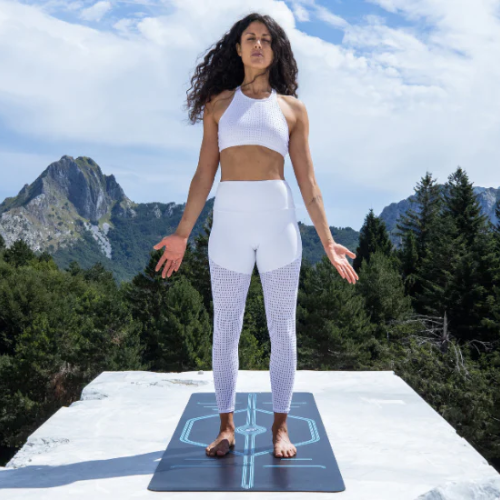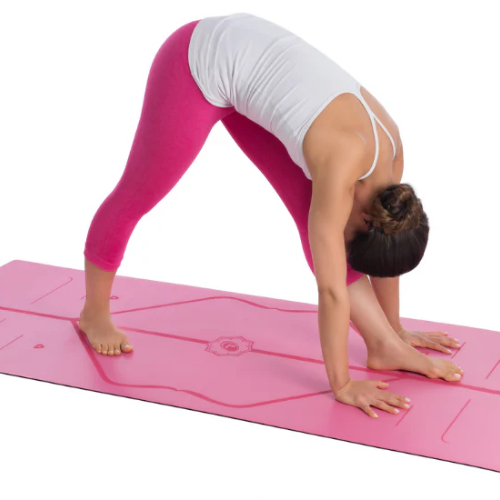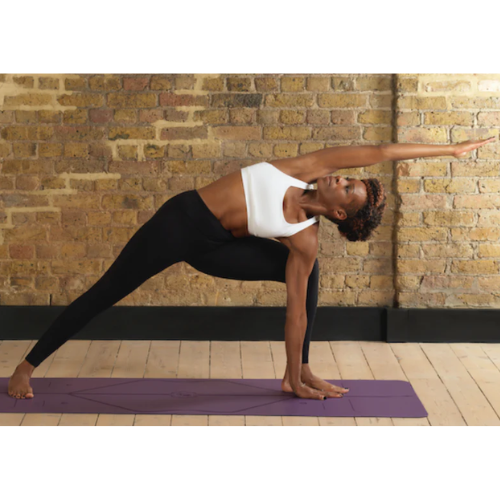20 Standing Yoga Poses: The Foundations of Flow

Standing poses are built from the ground up, starting with the alignment of your feet, stacking your joints, and positioning your pelvis, which can be either facing forward, as in Mountain Pose, or open to the side, as in Warrior II.
1. Mountain Pose (Tadasasana)

Sanskrit Meaning: Tada (Mountain)
Yoga Level: Beginner
Benefits: Establishes the foundation of our body in the right way and improves body awareness.
STEP BY STEP
Prime Position
Stand upright with your feet together or hip-width apart.
Distribute your weight evenly between your feet.
Keep your arms relaxed at your sides.

2. Raised Hands Pose (Urdhva Hastasana)
Sanskrit Meaning: Urdhva (Upwards) Hasta (Hand)
Yoga Level: Beginner
Benefits: A wonderful stretch for the abdomen, back, shoulders, and arms.
Step-by-Step:
- From Mountain Pose, inhale to take your arms out to the side and up towards the ceiling.
- You can bring your palms to touch overhead or keep the palms facing each other at shoulder width apart.
- Lift your gaze up to your thumbs.

3. Standing Forward Fold Pose (Uttanasana)
Sanskrit Meaning: Uttanana (Intense Stretch)
Yoga Level: Beginner
Benefits: Opens the hamstrings, glutes, and back muscles.
Step-by-Step:
- From Raised Hands Pose, exhale to release your arms as you swan dive over your legs while tipping your pelvis forward.
- Bring your fingertips to the floor or your ankles.
- Release your head.

4 .Chair Pose (Utkatasana)
Sanskrit Meaning: Utkata (Powerful)
Yoga Level: Beginner
Benefits: Strengthens your thighs. Stretches your back and shoulders.
Step-by-Step:
- From Mountain Pose, bend your knees forward to bring your butt back as if you were about to sit in a chair.
- Glance down at your knees and make sure you can see your toes peeking out from underneath.
- Lift your arms to align with the diagonal of your torso.

5. Downward Facing Dog Pose (Adho Mukha Svanasana)
Sanskrit Meaning: Adho (Downward) Mukha (Face)Svana (Dog)
Yoga Level: Beginner
Benefits: Improves core, leg, and arm strength. Opens the backs of your legs and back muscles.
Step-by-Step:
- Begin in a hands-and-knees position.
- Curl your toes under. On an exhalation, press into your palms to lift your butt toward the ceiling and straighten your legs.
- Your body is in the shape of an inverted V.
- Continue pressing into your palms and releasing your heels toward the floor.
- Let your head hang heavy.

6. Warrior I Pose (Virabhadrasana I)
Sanskrit Meaning: Virabhadra (a Hindu warrior)
Yoga Level: Beginner
Benefits: Strengthens the legs and core. Improves awareness of hip alignment.
Props: use the 45° Lines on your Align-For-Me system to help set up your feet correctly.
Step-by-Step:
- From Downward Facing Dog, step your right foot forward to the inside of your right hand.
- Pivot on the ball of your left foot to release your left heel to the mat at a 45-degree angle.
- On an inhalation, lift your hands away from the mat to bring your torso up to a standing position.
- Readjust your feet toward either side of your mat for greater stability and to allow your pelvis to point forward as it would in Mountain Pose.
- Bend your right knee over your right ankle and inhale to lift your arms overhead.
- Bring your palms to touch or keep your hands shoulder distance apart with the palms facing each other.
- Take your gaze up toward your thumbs.

7. Humble Warrior Pose
Also Known As: Devotional Warrior Pose
Yoga Level: Intermediate
Benefits: Improves leg and core strength. Opens the shoulder and back muscles.
Step-by-Step:
- From Warrior I, interlace your hands behind your back and draw your knuckles down, straightening your arms.
- Forward fold to the inside of your right foot taking your clasped hands up toward the ceiling.
- Keep hugging your head towards the midline to maintain Warrior I position of the hips and legs.

8. Pyramid Pose (Parsvottanasana)
Sanskrit Meaning: Parsva (Side) Uttana (Intense Stretch)
Yoga Level: Beginner
Benefits: A stretch for the hamstrings and back.
Props: Blocks are helpful if your hands don’t comfortably reach the floor in a forward fold.
Step-by-Step:
- From Warrior I Pose, straighten your right leg, and step your left foot forward 10 to 12 inches keeping the 45-degree turn out of the left toes.
- Put your hands on your hips to check that they are facing forward in Mountain Pose position.
- On an exhalation of breath, keep your spine long as you forward fold over your right leg.
- Keep your right knee slightly softened to prevent hyperextension.
- Bring your hands to the floor or blocks on either side of your right foot.
- Continue to lengthen your spine on your inhales and deepen your forward fold on your exhales.

9. High Lunge Pose
Yoga Level: Beginner
Benefits: Strengthens your legs and core. Improves balance.
Step-by-Step:
- From Downward Facing Dog, step your right foot to the inside of your right hand.
- On an inhalation, lift your torso toward the ceiling with your arms raised and your right knee bent over your right ankle.
- Bring your right thigh parallel to the floor and slide your shoulders down your back.

10. Warrior III Pose (Virabhadrasana III)
Sanskrit Meaning: Virabhadra (a Hindu warrior)
Yoga Level: Intermediate
Benefits: Strengthens the legs and core. Improves balance and body awareness.
Step-by-Step:
- From Warrior I with your right foot forward, come up onto the ball of your left foot.
- Lean your torso forward and push off your left foot to lift it away from the floor and take your weight into your right leg,
- Put your hands on your hips to make sure that they are level and facing forward as you lift your left leg towards parallel to the floor. Flex strongly into your left foot.
- Take your arms alongside your ears so there is a straight line from your fingertips to your heel.

11. Warrior II Pose (Virabhadrasana II)
Sanskrit Meaning: Virabhadra (a Hindu warrior)
Yoga Level: Beginner
Benefits: Strengthens the arms, legs, and core. Improves balance and awareness of open hip alignment.
Step-by-Step:
- From Warrior I with the right foot forward, turn your left toes out so your left foot is perpendicular to the Central Line.
- Move your front right foot to the Central Line and open your hips and shoulders to the left.
- Bend your right knee over your right ankle. You may need to scoot your left foot back a little bit.
- Your pelvis and chest will face the left side of your mat.
- Bring your arms parallel to the floor with the right arm forward and the left arm back.
- Take your gaze out over your right fingertips.

12. Reverse Warrior Pose
Also Known As: Peaceful Warrior Pose
Yoga Level: Beginner
Benefits: Strengthen your legs. Elongates your side body and intercostal muscles.
Step-by-Step:
- From Warrior II with the right foot forward, inhale and lift your right arm alongside your right ear.
- Extend your spine to reach your left hand down the back of your left leg and take a backbend towards the back of the room.
- Make sure your right knee stays over your right ankle.

13. Extended Side Angle Pose (Utthita Parsvakonasana)
Sanskrit Meaning: Utthita (Extended) Parsva (Side) Kona (Angle)
Yoga Level: Beginner
Benefits: Strengthens your legs and core. Opens your hips, shoulders, and back.
Props: A block inside your front foot can allow you to open your chest more fully.
Step-by-Step:
- From Warrior II, reach your right hand forward and place your palm inside of your right foot
- Use the traction between your right shoulder and right knee to open your chest toward the ceiling.
- If you can’t open the chest comfortably, take a block under your right hand or take the right forearm to the top of your right thigh instead.
- Lift your left arm and your gaze toward the ceiling.
- Keep your right knee over your right ankle throughout.
- Lower your left arm over your left ear if you want.

14. Triangle Pose (Trikonasana)
Sanskrit Meaning: Trikona (Triangle)
Yoga Level: Beginner
Benefits: Opens your hamstrings, chest, and sides.
Props: A block under the lower hand can be helpful.
Step-by-Step:
- From Warrior II with the right foot forward, straighten your right leg.
- Draw your right arm forward as much as possible, deepening your right hip crease.
- Lower your right hand to your right ankle, shin, or a block placed inside or outside your right leg.
- Stack your left arm over your right arm and turn your chest and your gaze toward the ceiling.

15. Half Moon Pose (Ardha Chandrasana)
Sanskrit Meaning: Ardha (Half) Chandra (Moon)
Yoga Level: Intermediate
Benefits: Improves balance and leg strength. Opens your hamstrings and chest.
Props: A block under your lower hand can improve your alignment.
Step-by-Step:
- From Warrior II, lower your right hand to the outside of your right foot.
- Keeping your right knee soft, lift your left foot off the floor and move your right hand forward 8 to 12 inches.
- Stack your pelvis over your right foot and straighten your right leg.
- Kick strongly out the heel of your straight left leg and make sure your pelvis is oriented towards the side of your mat in a Warrior II position.
- Open your left arm and chest toward the ceiling and take your gaze up to your left fingertips.

16. Tree Pose (Vrksasana)
Sanskrit Meaning: Vrksa (Tree)
Yoga Level: Beginner
Benefits: Improves leg strength and balance.
Step-by-Step:
- From Mountain Pose, shift your weight into your right leg while keeping your pelvis pointing forward.
- Lift your left foot away from the floor and place the sole of the left foot inside your right thigh.
- Press your foot into your thigh and your thigh back into your foot to keep your pelvis in the same forward-facing position as Mountain Pose.
- On an inhalation, lift your arms and your gaze toward the ceiling.

17. Half Lotus Tree Pose (Ardha Padmasana Vrksasana)
Sanskrit Meaning: Ardha (Half) Padma (Lotus)Vrksa (Tree)
Yoga Level: Intermediate
Benefits: Improves leg strength and balance. Hip opener.
Step-by-Step:
- From Tree Pose, slide the top of your left foot into your right hip crease in Half Lotus position.
- Your left knee points towards the floor as you press your left foot into your right leg.

18. Eagle Pose (Garudasana)
Sanskrit Meaning: Garuda (Eagle)
Yoga Level: Intermediate
Benefits: Improves balance and pelvic alignment awareness. Stretches the upper back and shoulders.
Step-by-Step:
- From Chair Pose, take your weight into your right leg.
- Lift your left foot off the floor and wrap your left thigh over your right thigh.
- Hook your left foot behind your right calf.
- Keep your pelvis in a forward-facing Mountain Pose position.
- Take your left arm under your right arm. Bend both elbows and wrap your left palm around your right forearm so that your palms touch.
- Lift your upper arms parallel to the floor while sliding your shoulders down your back.

19. King Dancer Pose (Natarajasana)
Sanskrit Meaning: Nataraja (King of the Dance)
Yoga Level: Intermediate
Benefits: Improves leg and core strength. Opens the shoulders and chest.
Step-by-Step:
- From Mountain Pose, take your weight into your right leg.
- Lift your left foot off the floor and bend your left knee so that your left foot comes close to your left buttock.
- Reach your left hand back and hold the outside of your left foot with your thumb pointing down.
- Take your right arm up towards the ceiling.
- Begin to rotate your pelvis forward so your upper body comes forward and your left thigh comes toward the ceiling.
- Press your left foot into your left hand to continue opening your chest and taking your left knee higher

20. One-Legged Chair Pose (Eka Pada Utkatasana)
Sanskrit Meaning: Eka (One) Pada (Foot) Utkata (Powerful)
Yoga Level: Intermediate
Benefits: Gentle hip opener and balance challenge. Builds leg strength.
Step-by-Step:
- From Chair Pose, transfer your weight into your right leg without moving your pelvis.
- Lift your left foot off the floor and bring your left ankle to the top of your right thigh with your left knee pointing left.
- Flex your left foot strongly.
- Take your hands to heart centre or overhead.5
- Maintain Chair Pose position in your right leg.



